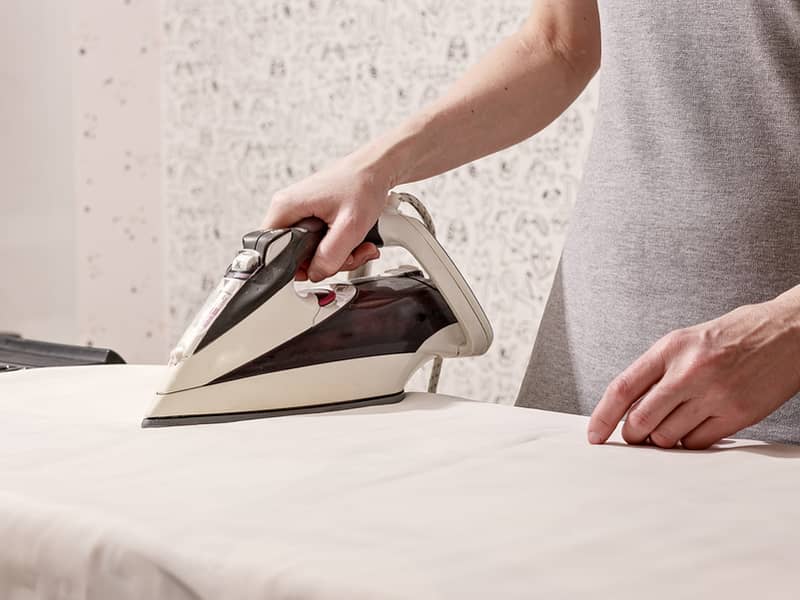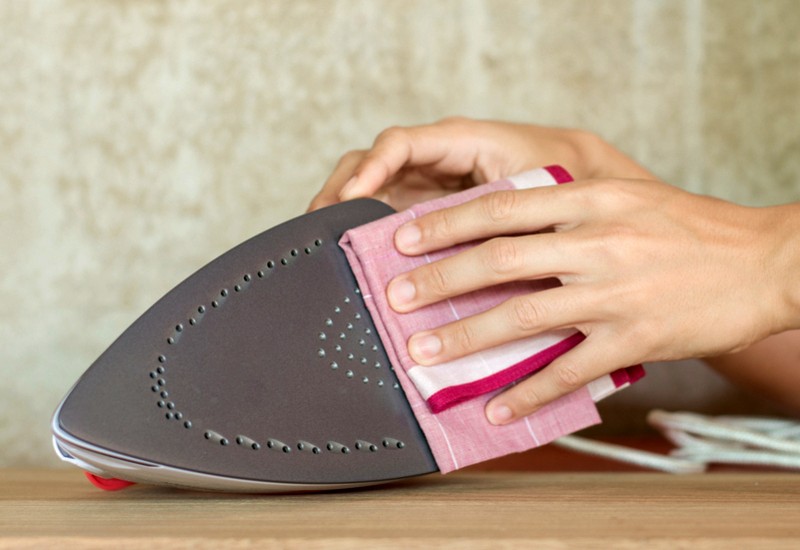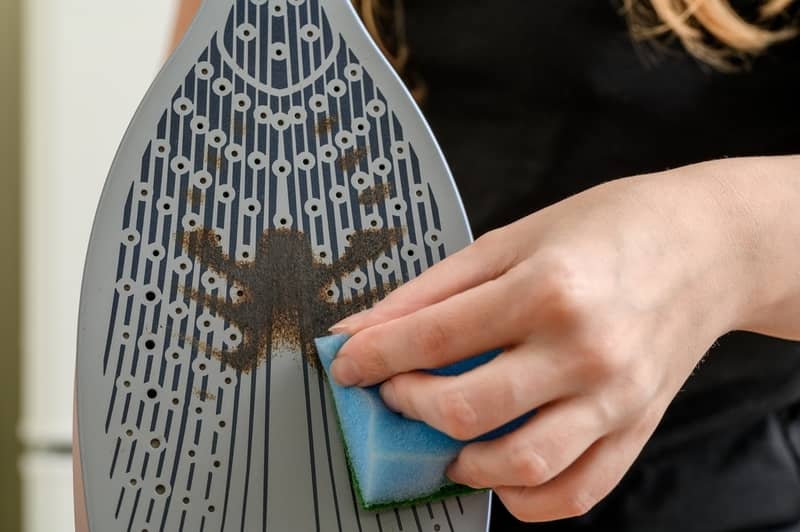Newly-laundered and ironed clothes feel so good — the fresh detergent scent, the soft and warm fabric. But while you probably cleaned the washer in between loads, when did you last clean the iron?
Yep, you do need to clean an iron so your clothes are perfectly pressed after washing. Otherwise, you could be transferring dirt back onto clean garments or preventing your iron from working properly!
How to clean an iron? It’s pretty straightforward — wipe the soleplate clean with a soft cloth and some soapy water or white vinegar, then scrub the steam vents clean with an old toothbrush or cotton bud.
Nobody wants to put away wrinkly, dirty clothing, so keep your iron in good condition! Then you’ll always have garments that are nice and neat… until it’s time to toss them into the wash again.
Before Cleaning | Cleaning an Iron Soleplate | Cleaning Iron Steam Vents | Cleaning a Burnt Iron | Removing Melted Plastic
How Often to Clean an Iron
If you use your iron daily, clean it once a month. This helps remove residue that could transfer to your clothes or clog up the steam vents.
For less frequent use, you can get away with cleaning the iron every 2–3 months.
You should clean your iron immediately if you notice:
- Melted plastic (or other messes)
- Fabric that drags or sticks to the iron
- Stains or marks on clothes after ironing
- White film or chalky residue on the soleplate
Before Cleaning Your Iron
Do not do anything before unplugging your iron and letting it cool completely.
If the iron is still hot, you could injure yourself or scorch the cleaning solution onto the soleplate — and end up with an iron that’s dirtier than when you started!
Empty the water reservoir as well.
To clean the iron soleplate, use either mild dish soap or distilled white vinegar, plus warm water.
Stick to non-abrasive or mildly abrasive cleaning tools, including:
- Cotton buds
- Old toothbrush
- Soft cloths or sponges
Do not use harsh chemicals like bleach, which could damage the soleplate. Avoid using highly abrasive cleaners like steel wool or scouring pads — you don’t want to scratch the material.
How to Clean an Iron Soleplate
The soleplate (also called a baseplate or iron plate) is the plate at the bottom of your iron, which presses down on your clothes.
It’s usually made of stainless steel, but other iron soleplate materials include aluminium, ceramic, and non-stick coating.
How you clean an iron soleplate depends on the material!
Cleaning an iron plate with dish soap
When cleaning an iron with a nonstick iron plate (like a Teflon iron), stick to gentle solutions like dish soap so you don’t damage the surface. The same goes for aluminium soleplates.
Mix a few drops of mild dish soap in some warm water until sudsy. Dip a soft microfibre cloth or non-abrasive sponge into the solution, then wring it out.
Gently scrub the soleplate clean, paying special attention to any scuffs or marks. Wipe away any soapy residue with a cloth dampened with clean water, then dry the soleplate.
Cleaning an iron plate with white vinegar
For stainless steel and ceramic soleplates, opt for white vinegar.
To clean an iron with vinegar, mix equal parts white vinegar and warm water, then dip in a microfibre cloth. Wring it out so it’s just damp before using that to wipe the iron clean.
For very stubborn residue — such as mineral deposits from hard water — soak an old towel or paper towel in the vinegar mixture. Place the cool iron on top for up to 10 minutes.
Wipe off any residue with a damp cloth, then follow with a clean cloth to dry.
Using a commercial iron plate cleaner
There are commercial products formulated for cleaning iron soleplates, such as Faultless Hot Iron Cleaner or EZ-Off Hot Iron Cleaner.
Double-check the product instructions, especially whether to use the product on a cold or hot iron! And always work in a well-ventilated space, with the appropriate precautions (such as a face mask).
How to Clean Iron Steam Vents
Besides the soleplate, you’ll also need to clean the steam vents on your iron!
Mineral deposits and other dirt can build up in the vents over time, which could lead to a blockage or cause your iron to malfunction.
For light dirt, use an old toothbrush or a cotton bud to clean the steam vents — carefully! Dip the tool in the vinegar mixture, then swab (or scrub) each vent clean.
For a more thorough clean, check if the iron manufacturer allows you to use vinegar. If yes, fill the water reservoir with equal parts white vinegar and distilled water.
Plug in the iron and switch it onto a high heat setting, then place it over a bowl or some old rags. Hold the steam button for 20–30 seconds, and repeat several times to flush out the dirt.
You can also check if your iron has a steam clean setting, or iron some old clothes.
Once the reservoir is empty, switch off the iron and let it cool completely. Use an old toothbrush to scrub the vents clean before drying the surfaces.
If the manufacturer does not allow you to put vinegar inside the iron, look for dedicated descaling products such as Sunbeam’s Iron Cleaner. Follow the product instructions for use.
How to Clean a Burnt Iron
Ironing incorrectly (such as a too-high setting) can sometimes leave burn marks on the soleplate. The sooner you tackle a burnt iron, the easier it’ll be to clean.
As always, unplug the iron and allow it to cool down first. Then choose one of the following methods to get the brown stuff (burn marks) off your iron.
Using baking soda and vinegar
Remember, do not mix the two together! Baking soda and vinegar will cancel each other out, making them less effective.
Instead, start by making a thin paste out of baking soda and water. Apply it to the soleplate with a damp sponge, then gently clean the burnt material off the iron.
When you’re done scrubbing, lightly spray some vinegar onto the surface or apply it with a soft cloth. The vinegar will help remove any remaining burn residue as well as the paste.
Wipe the soleplate clean with a damp cloth, then dry.
Using white toothpaste
Make sure to use white, non-gel toothpaste! Otherwise, you could leave a stain or some residue on the plate.
To clean a burnt iron with toothpaste, squeeze out a tiny dab onto a damp, non-abrasive sponge. Then carefully scrub the affected area on the soleplate until the marks lift.
Wipe the soleplate clean with a clean cloth dampened with fresh water, then dry the surface.
How to Remove Melted Plastic From an Iron
If you accidentally ironed over some plastic and it melted, don’t panic!
Your first step is always to unplug the iron immediately and let it cool. Open the windows or an exhaust fan to vent out the fumes.
Use a wooden or silicone scraper to remove as much plastic as possible from the surface while it’s still warm.
If that doesn’t work — or there’s leftover residue — place some ice cubes in a bowl and layer a kitchen towel on top. Set the iron plate onto the towel to harden the plastic, then chip it off with the scraper.
Once that’s done, get the remaining traces off with a thin paste of baking soda and water. Apply it with a damp sponge, then gently scrub the soleplate clean.
Wipe away any residue with a damp cloth, then dry the surfaces.
Tips for Maintaining Your Iron
When using your iron, follow the manufacturer’s instructions, especially for the settings! Using too-high heat can burn the fabric or even the soleplate.
Use distilled water in the reservoir if possible. Tap water (even filtered) may contain minerals and particles that can clog or corrode the iron.
Fill the water reservoir before plugging in your iron, and empty it afterwards to prevent mineral buildup. Leave the cap open for an hour or two so the reservoir can air dry.
Wipe off any excess moisture before you put the iron away. And always store your iron upright!
Avoid ironing over clothing accessories such as hooks, snaps, screen prints, and zippers, as these risk damaging the soleplate. If necessary, layer a pressing cloth (or a towel) over the garment first.
Keeping your iron clean keeps it working better and longer. Otherwise, it could get your clothes dirty after you wash them — and what a waste that would be!




